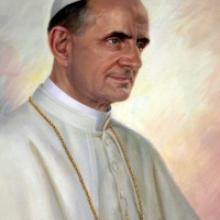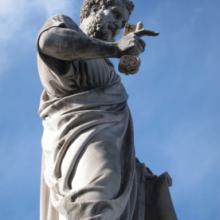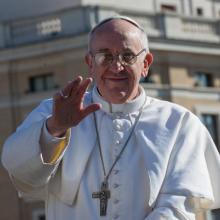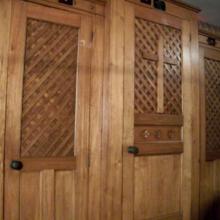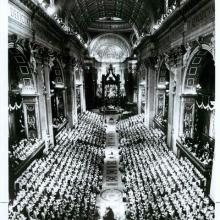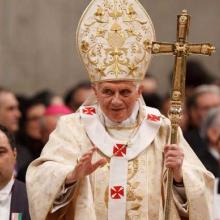second vatican council
Even by this pope’s standards it was a bold move.
Francis, the spiritual leader of more than a billion Roman Catholics across the globe, this week traveled to Sweden, one of the most secularized countries in Europe, to take part in events marking 500 years since Martin Luther kickstarted the Protestant Reformation.

Image via Tatjana Splichal/Shutterstock.com
In a telephone interview, Bornhoft stood by his critique, but said he understood the sense of powerlessness that seemed to motivate many liturgy shamers:
“There are a lot of liturgical issues today and they don’t trust that leadership can do anything. So they see liturgy shaming as an important and effective tool we didn’t have before.”
Indeed, diehard traditionalists — who tend to be the main liturgy-shamers — say the stakes are too high and they don’t feel they have a choice.
As he wraps up a Vatican meeting marked by sharp debates over sex and morality, Pope Francis on Oct. 19 will honor one of his most controversial predecessors by beatifying Pope Paul VI, who is most famous for reaffirming the Catholic Church’s ban on artificial contraception.
Beatification puts Paul one step shy of formal sainthood. The move might seem out of step with Francis’ pastoral approach given that Paul’s birth control ruling, in the 1968 encyclical “Humanae Vitae,” set the stage for the culture wars that overtook Catholicism after Paul died in 1978.
A wide swath of Catholics, especially in the U.S. and Europe, were furious over Paul’s decision. They were convinced that the ban would be lifted and that Paul was shutting down the reforms that had begun a few years earlier with momentous changes adopted by the Second Vatican Council.
Many conservatives, on the other hand, hailed “Humanae Vitae” for reasserting traditional doctrine, and the division foreshadowed the deep splits that have played out even in this month’s high-level synod in Rome — a polarization that Francis says he wants to overcome.
Yet Francis is trying to accomplish that goal by focusing not so much on “Humanae Vitae” but on Paul VI’s many other groundbreaking, though often overlooked, contributions:
This weekend, more than 800,000 spectators crowded the St. Peter’s Square area while 500,000 more watched on giant screens around Rome as Pope Francis canonized Pope John XXIII and Pope John Paul II. The first time a pope has sainted two popes at the same time, this historic event has been called a savvy political move by the media, since Pope Francis recognized both the more liberal John XXIII and the more conservative John Paul II, thus satisfying two opposing wings of the Roman Catholic church. While Pope Francis did indeed display political savvy at this canonization, this event holds far more significance than that (even leaving aside the spiritual question of discerning sainthood).
It’s almost a year since Pope Francis was chosen as Benedict XVI’s successor. The Argentinian-born pontiff has quickly achieved global fame for his numerous statements indicating that significant changes may be coming to the Roman Catholic Church.
One possible change emerged last month when London’s Sunday Times reported that Francis wants to make public the Vatican’s archives of Pius XII’s pontificate. Eugenio Pacelli became pope in 1939 and served as pontiff during the period of World War II and the Holocaust until his death in 1958.
According to the British newspaper, Francis wants to release the Pius XII papers for study before determining whether to consider his controversial predecessor for sainthood. Francis has already “fast-tracked” the path to sainthood for John XXIII and John Paul II, but not Pius XII.
Vatican theologians have given their approval to a miracle attributed to the intercession of Pope Paul VI, moving him a step closer to sainthood.
The team of medical professionals and doctors that advise the Vatican’s Congregation for the Causes of Saints already had approved the same miracle in December. Now that a panel of theologians has signed off, the miracle only requires a review by Pope Francis to be considered official.
When that happens, Paul will be beatified — the final step before sainthood. A second miracle is typically required for canonization.
The Vatican said it would display for the first time bones believed to be the mortal remains of St. Peter, the leader of Jesus’ 12 apostles, to mark the end of the Year of Faith on Nov. 24.
Archbishop Rino Fisichella, president of the Pontifical Council for Promoting New Evangelization, wrote in Monday’s editions of L’Osservatore Romano, that the Catholic faithful making a pilgrimage to St. Peter’s tomb to mark the end of the Year of Faith will enjoy “the exposition … of the relics traditionally recognized as those of the apostle who gave his life for the Lord on this spot.”
Fisichella was referring to the long-held belief that Peter was crucified upside down and died in either A.D. 64 or 67 on the spot now marked by the Clementine Chapel inside the basilica that bears his name.
Popes John Paul II and John XXIII will be formally declared saints on April 27, 2014, the Vatican said Monday. Pope Francis made the announcement during a meeting with cardinals gathered in Rome.
John Paul, who was pope from 1978 to 2005, and John, who reigned from 1958 to 1963, are considered two of the most influential religious leaders in the world in the last century, and they represent two poles in Roman Catholicism — John XXIII is a hero to liberals, while John Paul II is widely hailed by conservatives.
Pope Francis declared on Friday that Popes John Paul II and John XXIII will be made saints, elevating the two most decisive popes of the 20th century to the pantheon of Catholic life and worship.
In a sign of the worldwide devotion for John XXIII, known as “Good Pope John,” Francis waived the requirement for a second miracle credited to John XXIII’s intercession, with the Vatican’s spokesman saying, “no one doubts his virtues.”
Francis signed off on a decree recognizing the second miracle attributed to the Polish-born John Paul II, who reigned from 1978 to 2005 , and is credited with globalizing the papacy and playing a key role in the downfall of the communist regimes of Eastern Europe.
In his first official meeting with a Jewish delegation, Pope Francis on Monday reaffirmed the Catholic Church’s condemnation of anti-Semitism and vowed to further deepen Catholic-Jewish relations.
“Due to our common roots, a Christian cannot be anti-Semitic!” he told a delegation of the International Jewish Committee for Interreligious Consultations, the Vatican’s official partner for interfaith dialogue with the world’s Jews.
In his speech, Francis stated that the church condemns “hate, persecution, and all manifestations of antisemitism.”
DERBY, Conn. — The Rev. Janusz Kukulka can’t say for sure that his parishioners are sinning more, but they sure are lining up at the new confessional booth to tell him about it.
For years, Kukulka, was content with absolving sins in a private room marked by an exit sign to the right of the altar St. Mary the Immaculate Conception Catholic Church.
But something happened during Lent this year. For the first time, Kukulka really noticed the two confessionals missing from the rear of his church. They’d been gone for four decades, ripped out during the 1970s to make room for air conditioning units during a renovation inspired by the Second Vatican Council.
They must have been a thing of beauty, Kukulka thought. He imagined their dark oak paneled doors and arched moldings to match the Gothic architecture of the church designed by renowned 19th-century architect Patrick Keely.
Their absence was striking, especially when the Archdiocese of Hartford had asked parishes to extend their confession hours during Lent, part of a public relations campaign to get Catholics to return to the sacrament of reconciliation.
So, one Sunday Kukulka announced his desire to the congregation. “I told them I wanted a visible confessional,” he said.
He got one within a week.
Fifty years ago hundreds of elaborately robed leaders strode into St. Peter's Basilica in a massive display of solemn ecclesiastical pomp. It signaled the start of a historic three-year assembly that would change the way members of the world’s largest Christian denomination viewed themselves, their church and the rest of the world.
It was the first day of the Second Vatican Council, more popularly known as Vatican II, which was designed to assess the church’s role in a rapidly changing world. Leading the prelates was Pope John XXIII, who said frequently that he convened the council because he thought it was time to open the windows and let in some fresh air.
For many Catholics, the air came in at gale force.
As a result of Vatican II, priests started celebrating Mass in the language of the countries in which they lived, and they faced the congregation, not only to be heard and seen but also to signal to worshippers that they were being included because they were a vital component of the service.
“It called for people not to have passive participation but active participation,” said New Orleans Archbishop Gregory Aymond, who chairs the Committee on Divine Worship for the U.S. Conference of Catholic Bishops. “Prayer is not supposed to be a performance. We’re supposed to be actively participating.”
VATICAN CITY — Fifty years after the Second Vatican Council revolutionized life inside the Roman Catholic Church, hundreds of bishops from around the world are gathered in Rome to confront an external threat: a mounting tide of secularization.
The Synod of Bishops on “New Evangelization” brings together 262 top church leaders for a three-week summit at the Vatican, joined by lay experts and representatives of other Christian groups.
In a wide-ranging speech aimed at setting the tone for the bishops' discussion, Washington Cardinal Donald Wuerl called on Christians to “overcome the syndrome of embarrassment” about their faith with a more assertive offense against the “tsunami of secular influence” that is sweeping away “marriage, family, the concept of the common good and objective right and wrong.”
Wuerl has been appointed by Pope Benedict XVI as the “relator general” of the synod, with the key task of summing up the main points of the bishops' discussions.
Combining images and words from advertising, pop culture, and religion, the bold graphic art of Sister Mary Corita was as deeply representative of the spirit of the 1960s as it was ubiquitous in church basements, dorm rooms. and urban communes of people involved in the struggle for civil rights and the campaign to end the Vietnam War.
In today's visual and graphically dominant popular culture, Corita's work — her bold typography, vivid colors, the use of ad logos and slogans — resonates with a new generation, attracted by what has been called "her festive involvement in the world'' and her interest in "blurring the lines between art and life.''
"Corita's art from the 1960s, which is based in advertising, has this great pop appeal to us today in our media-saturated culture,'' said Kathryn Wat of the National Museum of Women in the Arts in Washington.
The Catholic church is reeling from the several sexual abuse allegations that have come to light over the past three months. Downplaying the severity of this scandal will only further damage the already beleaguered church's image and credibility. Many in the media blame Pope Benedict XVI for the mismanagement of the sexual abuse crisis.



